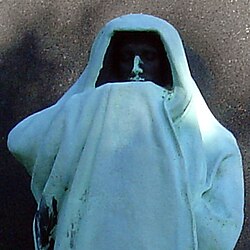
Graceland Cemetery is a large historic garden cemetery located in the north side community area of Uptown, in Chicago, Illinois, United States. Established in 1860, its main entrance is at the intersection of Clark Street and Irving Park Road. Among the cemetery's 121 acres (49 ha) are the burial sites of several well-known Chicagoans.

Lorado Zadok Taft was an American sculptor, writer and educator. Part of the American Renaissance movement, his monumental pieces include, Fountain of Time, Spirit of the Great Lakes, and The Eternal Indian. His 1903 book, The History of American Sculpture, was the first survey of the subject and stood for decades as the standard reference. He has been credited with helping to advance the status of women as sculptors.

Evelyn Beatrice Longman was a sculptor in the U.S. Her allegorical figure works were commissioned as monuments and memorials, adornment for public buildings, and attractions at art expositions in early 20th-century America. She was the first woman sculptor to be elected a full member of the National Academy of Design in 1919.

The Eternal Indian, sometimes called the Black Hawk Statue, is a 48-foot sculpture by Lorado Taft located in Lowden State Park, near the city of Oregon, Illinois. Dedicated in 1911, the statue is perched over the Rock River on a 77-foot bluff overlooking the city.

Carl Augustus Heber was an American sculptor noted for his public monuments.

Allen George Newman III was an American sculptor, best known for his statue "The Hiker".

Fountain of Time, or simply Time, is a sculpture by Lorado Taft, measuring 126 feet 10 inches (38.66 m) in length, situated at the western edge of the Midway Plaisance within Washington Park in Chicago, Illinois, in the United States. The sculpture is inspired by Henry Austin Dobson's poem "Paradox of Time". Its 100 figures passing before Father Time were created as a monument to the 100 years of peace between the United States and the United Kingdom following the Treaty of Ghent in 1814. Father Time faces the 100 from across a water basin. The fountain's water was turned on in 1920, and the sculpture was dedicated in 1922. It is a contributing structure to the Washington Park United States Registered Historic District, which is a National Register of Historic Places listing.

Nellie Verne Walker, was an American sculptor best known for her statue of James Harlan formerly in the National Statuary Hall Collection in the United States Capitol, Washington D.C.

The Eagle's Nest Art Colony, the site known in more modern times as the Lorado Taft Field Campus, was founded in 1898 by American sculptor Lorado Taft on the bluffs flanking the east bank of the Rock River, overlooking Oregon, Illinois. The colony was populated by Chicago artists, all members of the Chicago Art Institute or the University of Chicago art department, who gathered in Ogle County to escape the summer heat of Chicago. The colony complex has been used as a field campus for Northern Illinois University since 66 acres (27 ha) of Lowden State Park were turned over to the university by the state of Illinois.
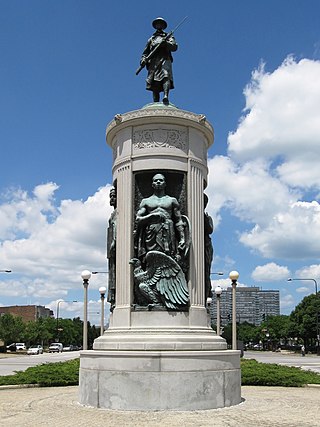
Erected in 1927, the Victory Monument, is a bronze and granite sculptural monument, based on a concept by John A. Nyden, and sculpted by Leonard Crunelle. It was built to honor the Eighth Regiment of the Illinois National Guard, an African-American unit that served with distinction in France during World War I. It may be the only memorial statue dedicated to African-American soldiers of the Great War.

Fountain of the Great Lakes, or Spirit of the Great Lakes Fountain, is an allegorical sculpture and fountain by Lorado Taft. The bronze artwork, created between 1907 and 1913, depicts five women arranged so that the fountains waterfall recalls the waterflow through the five Great Lakes of North America. In the Great Lakes, the waterflow begins in Lake Superior at 600 feet (180 m) above sea level and continues eastward through each lake until it reaches Lake Ontario. The Fountain is one of Taft's best known works. It is located in the public South McCormick Memorial Court of the Art Institute of Chicago, in the Chicago Loop.
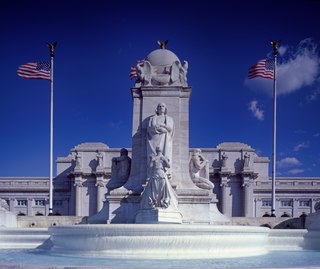
Columbus Fountain also known as the Columbus Memorial is a public artwork by American sculptor Lorado Taft, located at Union Station in Washington, D.C., United States. A centerpiece of Columbus Circle, Columbus Fountain serves as a tribute to the explorer Christopher Columbus. The unveiling in 1912 was celebrated all over Washington, DC over the course of three days with parades, concerts and fireworks gathering tens of thousands of people from all over the world.
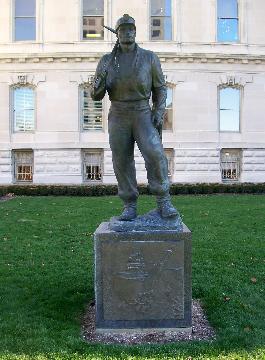
Coal Miner is a public artwork by Polish American artist John J. Szaton (1907–1966) which is located in two US State capitals; the original, commissioned in 1963 in Springfield, Illinois, as well as a copy on the west lawn of the Indiana State House in Indianapolis The statues commemorate coal miners who had lost their lives in those states' mining industry. The 7-foot (2.1 m) tall statue rests on a 3-foot (0.91 m) square, granite base supported by a cement foundation that is 4–6 inches (100–150 mm) thick.

Death and the Sculptor, also known as the Milmore Monument and The Angel of Death and the Young Sculptor is a sculpture in bronze, and one of the most important and influential works of art created by sculptor Daniel Chester French. The work was commissioned to mark the grave in Forest Hills Cemetery in Jamaica Plain, Boston, Massachusetts, of the brothers Joseph (1841–1886), James and Martin Milmore (1844–1883). It has two figures effectively in the round, linked to a background relief behind them. The right-hand figure represents a sculptor, whose hand holding a chisel is gently restrained by the fingers of the left-hand figure, representing Death, here shown as a winged female.
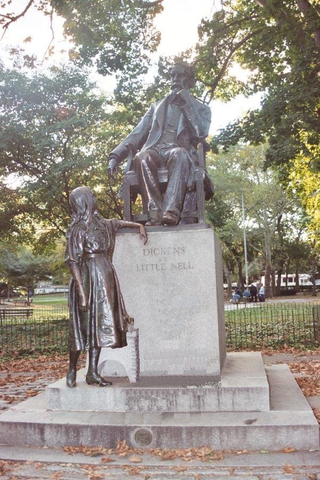
Dickens and Little Nell is a bronze sculpture by Francis Edwin Elwell that stands in Clark Park in the Spruce Hill neighborhood of Philadelphia. The sculpture depicts the 19th-century British author Charles Dickens and Nell Trent, a character from his 1840–41 novel The Old Curiosity Shop. The grouping was one of the most celebrated American sculptural works of the late 19th century.

The Martin Ryerson Tomb is an Egyptian Revival style mausoleum designed by Louis Sullivan and completed in 1889. It is in the historic Graceland Cemetery in Chicago, Illinois, United States.
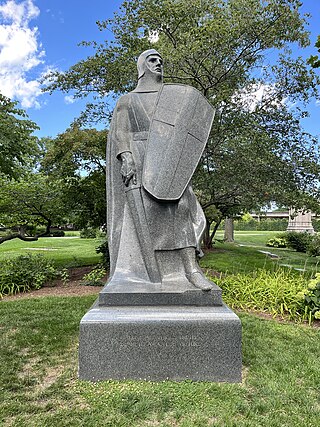
The Crusader, also known as the Victor Lawson Monument, is a memorial marking the grave of Chicago newspaper publisher Victor Lawson. It is in Chicago's historic Graceland Cemetery and was designed by American sculptor Lorado Taft in 1931.

The Schoenhofen Pyramid Mausoleum is a tomb in Graceland Cemetery, Chicago. It was designed by Chicago School architect Richard E. Schmidt as a family mausoleum for the Chicago brewer Peter Schoenhofen.
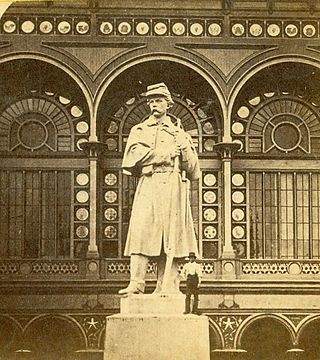
Carl H. Conrads was an American sculptor best known for his work on Civil War monuments and his two works in the National Statuary Hall Collection at the U.S. Capitol in Washington, D.C. He was also known as Charles Conrads.

The Ulysses S. Grant Monument is a presidential memorial in Chicago, honoring American Civil War general and 18th president of the United States, Ulysses S. Grant. Located in Lincoln Park, the statue was commissioned shortly after the president's death in 1885 and was completed in 1891. Several artists submitted sketches, and Louis Rebisso was selected to design the statue, with a granite pedestal suggested by William Le Baron Jenney. At the time of its completion, the monument was the largest bronze statue cast in the United States, and over 250,000 people were present at the dedication.
